Photo blog on nature, wildlife and macro entophiles photography. Photo and pictures of interesting places and landmark in Borneo and Borneo wallpaper download
Dec 23, 2010
Dec 5, 2010
Tropical Dove
Photo of a tropical dove relaxing during her morning sun-bath. The bird in the photo look like a Bar-shouldered Dove (Geopilia humeralis) or a Peaceful Dove (Geopelia striata).
The photo is shot with 24x digital zoom, so the photo quality is not pleasing.
Posted by RWS at 9:45 AM 4 comments
Labels: Bird
Nov 8, 2010
Red Powder Puff Flower - Sensitive Briar
Close up photo of tropical red Powder Puff Flower or Sensitive Briar. On a closer look, Powder Puff flower look like a Mimosa Pudica flower.
Calliandra haematocephala is a fast growing shrub that can grow tall but also spreads wide. If desired it can be kept smaller by trimming. Interesting enough the leaves close at night.
The buds before the flowers open look like raspberries. This large shrub can
be grown indoor if trimmed and grown in a pot but it will be best if you can grow it outside in a warm climate.
Powder Puffs come in white as well. Power Puff originated from Bolivia.
Recommended reading:
* Photo of Dillenia Suffroticosa - Simpoh Air
* Ixora Petal And Water Droplets
* Pitcher Plants, Nepenthes, Monkey Cup
Posted by RWS at 11:38 PM 4 comments
Labels: Flower
Oct 25, 2010
Chilasa clytia butterfly
Chilasa clytia, a common tropical butterfly found in Borneo. If not for the gloomy weather, the photo shoot would be perfect. The Chilasa clytia was just perching still on a flower and the air was still. A steady shot but lighting was a let down.
About a foot away in normal macro mode (not zero macro).
I think the photo above is about 5x lens zoom.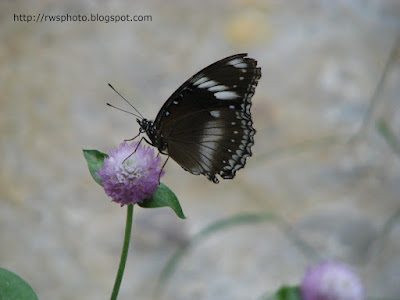
A normal shot.
See my Flickr gallery as well for more tropical butterflies.
Posted by RWS at 10:39 PM 10 comments
Labels: Insect - Butterfly
Oct 22, 2010
Dead Huntsman Spider
Photo of a dead Huntsman spider.
Recommended reading:
* Wasp spider of Borneo - Argiope bruennichi
Posted by RWS at 2:33 PM 1 comments
Labels: Insect - Spider
Oct 20, 2010
Borneo Red Ants
Red ants or fire ants from Borneo.

The bodies of fire ants, like all insects' bodies, are broken up into three sections: the head, the thorax, and the abdomen, with three pairs of legs and a pair of antennae. Fire ants can be distinguished from other ants by their copper brown head and body with a darker abdomen. The worker ants are blackish to reddish, and their size varies from 2mm to 6 mm (0.12 in to 0.24 in). These different sizes of the ants can all exist in the same nest.
Recommended photos:
* Macro photos of red fire ants
Posted by RWS at 9:52 PM 1 comments
Labels: Ant
Oct 14, 2010
Setora fletcheri slug caterpillar
Photo of a maroon spiky Setora fletcheri slug caterpillar. The slug caterpillar's decoration is not just for show. At any sign of danger, each cluster of spines blooms into a bristly sphere. Glands at the base of the spines produce venom rich in histamines--liquid peril for any would-be attacker.
Setora fletcheri showing warning coloration and spines loaded with toxins that erect when the slug is disturbed.
Photo shot at JP Jaban farm, 14th Mile Kuching Serian Road.
Posted by RWS at 12:30 PM 0 comments
Labels: Insect - Caterpillar
Oct 12, 2010
Baccaurea angulata - Belimbing Merah
Baccaurea angulata is a tropical wild fruit indigenous to Borneo. Baccaurea angulata is also known locally as Belimbing Merah, Belimbing Bukit, Gerumin Bereh (Bidayuh), Tampoi Merah, Uchong (Iban) or Belimbing hutan.
Elsewhere, this fruit is also called as Embaling (Sabah), Embaling bobou (Brunei) and Asem ketiak, pidau (Kalimantan).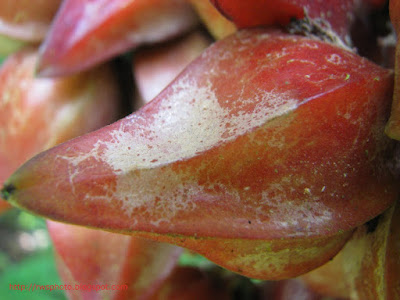
Baccaurea angulata is also close relative of the Starfruit (Averrhoa carambola). Some may called it Red Angle Starfruit.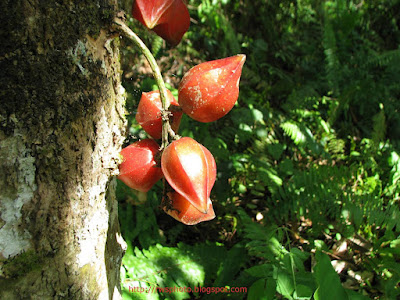
The Baccaurea angulata fruits have a tangy taste, both the aril and the skin. A seasonal fruit which is often seen from November to January, sold by roadside sellers and in native fruit and vege markets.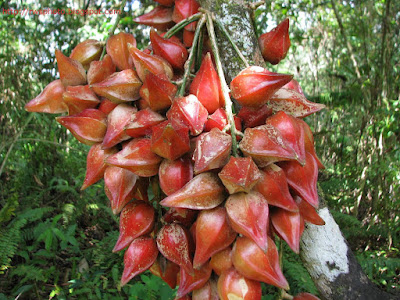
Ripen Baccaurea angulata are either in red or pinkish.
And when the season come, Baccaurea angulata is very generous with its fruits. The fruits are borne from the trunk and branches. Plentiful of them.
Baccaurea angulata may reach 8 m tall, profusely branched. Flowers (yellow) and fruits (red) colourful so may be planted as an ornamental. Fruits are angular and inside is white, juicy, sourish-sweet edible pulp.
Posted by RWS at 10:54 PM 4 comments
Labels: Fruit
Oct 6, 2010
Yellow Black Polka Dot Caterpillar
A photo of tiny yellow caterpillar will black dots.
Note: Photo was cropped.
Recommended reading:
* Photo collection of Tropical caterpillars
Posted by RWS at 1:23 AM 0 comments
Labels: Insect - Caterpillar
Oct 4, 2010
Macadamia Integrifolia Nuts
I get to hold a box of Macadamia Integrifolia Nuts, freshly flown from Hawaii. Would you believe it? Macadamia Integrifolia Nuts in Malaysia. And no, the nuts will not be roasted but destined to a nursery. Hawaii is the largest producer of Macadamia nuts.
Macadamia nuts (Macadamia integrifolia) are dry drupes containing a very hard seed-bearing endocarp. According to most botanical references, the outer husk represents part of the ovary wall or pericarp.
They are small to large evergreen trees growing to 2–12 m tall. The leaves are arranged in whorls of three to six, lanceolate to obovate or elliptical in shape, 6–30 cm long and 2–13 cm broad, with an entire or spiny-serrated margin. The flowers are produced in a long slender simple raceme 5–30 cm long, the individual flowers 10–15 mm long, white to pink or purple, with four tepals. The fruit is a very hard woody globose follicle with a pointed apex, containing one or two seeds.
The nuts are a valuable food crop. Only two of the species, Macadamia integrifolia and Macadamia tetraphylla, are of commercial importance. The remainder of the genus possess poisonous and/or inedible nuts, such as M. whelanii and M. ternifolia; the toxicity is due to the presence of cyanogenic glycosides.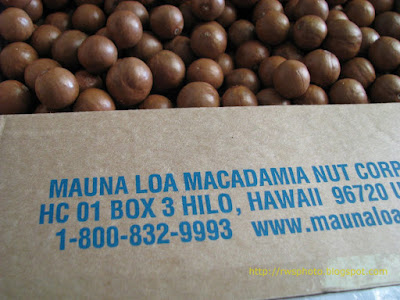
Macadamia tree cultivation and processing
The macadamia tree is usually propagated by grafting, and does not begin to produce commercial quantities of nuts until it is 7–10 years old, but once established, may continue bearing for over 100 years. The macadamia nut has an extremely hard shell, but can be cracked using a blunt instrument, such as a hammer or rock applied with some force to the nut sitting in a concave surface, or a custom made macadamia nutcracker can be used.
Macadamia Nuts in the Diet Lower Cholesterol
How many times have you said, "nuts to the diet." Well now perhaps it should be "nuts in the diet." It seems that macadamia nuts may be a good addition to the daily diet, particularly if you want to reduce blood cholesterol levels. Macadamia nuts like all non-animal foods contain no cholesterol. But they are remarkable in the fact that their fat contains over 86% monounsaturated fatty acids. The average macadamia nut will also add about 18 calories to your diet. Oil from the macadamia nut is used in the cosmetic industry because of similarities between the nut oil and human skin.
Recommended link:
* Fruits Called Nuts
* HAWAII MACADAMIA NUT ASSOCIATION
Posted by RWS at 9:50 PM 0 comments
Oct 2, 2010
Agarwood Aquilaria Crassna Saplings
Young Agarwood saplings between 3 to 4 inches in height and about one month old. The Agarwood species is of Aquilaria crassna, a resinous heartwood, used for perfume and incense. The resin is produced by the tree in response to infection by a parasitic ascomycetous mould, Phaeoacremonium parasitica, a dematiaceous (dark-walled) fungus.
When the Agarwood saplings reach the height of 3 to 4 inches, it can be transplanted into bags.
Photo taken at a nursery at 13th Mile Kuching-Serian road, just after the rain.
Agarwood is also locally known as Gaharu.
Posted by RWS at 1:13 AM 0 comments
Labels: plant
Sep 30, 2010
Kelpie and German Shepperd Puppy Faceoff
A local Kelpie faceoff with a German Shepperd puppy. Neither want to lose. 
The ancestors of the Kelpie were simply (black) dogs, called Colleys or Collies. The word "collie" has the same root as "coal" and "collier (ship)". Some of these collies were imported to Australia for stock work in the early 1800s, and were bred to other types of dogs (possibly including the occasional Dingo), but always with an eye to working sheep without direct supervision.
So I have no idea how a look alike Kelpie can found its way here, at Borneo.
Posted by RWS at 11:36 PM 0 comments
Labels: Pets
Sep 12, 2010
Blind Cat
Photo of a white blind cat. The blind cat belongs to my neighbor and they called the cat, Snowy.
 A blank stare.
A blank stare.
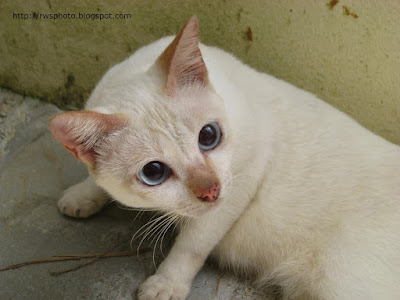 The cat use hearing to locate noises.
Recommended viewing:
* Orange Kitten
* Two cats and a string
* Newborn Kittens
The cat use hearing to locate noises.
Recommended viewing:
* Orange Kitten
* Two cats and a string
* Newborn Kittens
Posted by RWS at 1:10 PM 6 comments
Labels: Pets
Sep 4, 2010
Yellow Spiky Caterpillar - Series #20
A close up photo of a small pale yellow spiky caterpillar with an alien face (or is it Teenage Mutant Ninja Turtle face), perched on a mango leave. This specimen look like my previous luminous green Euclea delphinii catepillar.
 Here's the YouTube video clip of the above caterpillar:
Recommended reading:
* Giant Caterpillar - Series #19
* Furry caterpillar - Series #18
* Two caterpillars - Series #17
Here's the YouTube video clip of the above caterpillar:
Recommended reading:
* Giant Caterpillar - Series #19
* Furry caterpillar - Series #18
* Two caterpillars - Series #17
Posted by RWS at 1:05 PM 1 comments
Labels: Insect - Caterpillar, Nature
Aug 5, 2010
Paper Wasp foraging Dimocarpus malesianus fruit flowers
Photo of Paper Wasp foraging among the Dimocarpus longan malesianus fruit flowers.

Posted by RWS at 1:32 AM 2 comments
Labels: Insect - Wasps
Aug 4, 2010
Orange Kitten
Local orange kitten spotted escaping from her cage to take a sun bath. The orange kitten looks scruffy and she should be given a water bath instead.
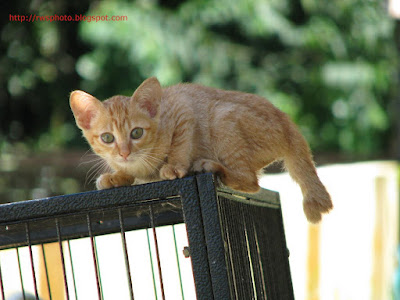


 By the way, the kitten belongs to my neighbor.
Recommended reading:
* Newborn Kittens
* Two cats and a string
* Mix Breed Siamese Cats Napping
By the way, the kitten belongs to my neighbor.
Recommended reading:
* Newborn Kittens
* Two cats and a string
* Mix Breed Siamese Cats Napping
Posted by RWS at 1:00 AM 2 comments
Labels: Pets
Aug 3, 2010
Four-angled Bean Flower
Photos of four-angled bean (or a winged bean) flower.
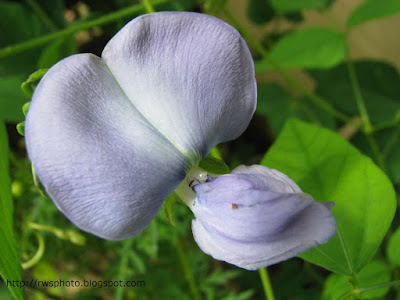
 The Winged bean (Psophocarpus tetragonolobus), also known as the Goa bean (kacang botol in Malaysia) and Asparagus Pea and Winged Pea (Lotus tetragonolobus), is a tropical legume plant native to Papua New Guinea. It grows abundantly in hot, humid equatorial countries, from the Philippines and Indonesia to India, Burma, Thailand and Sri Lanka. It does well in humid tropics with high rainfall. There are also varieties that can be grown in most areas of the U.S.
The Winged bean (Psophocarpus tetragonolobus), also known as the Goa bean (kacang botol in Malaysia) and Asparagus Pea and Winged Pea (Lotus tetragonolobus), is a tropical legume plant native to Papua New Guinea. It grows abundantly in hot, humid equatorial countries, from the Philippines and Indonesia to India, Burma, Thailand and Sri Lanka. It does well in humid tropics with high rainfall. There are also varieties that can be grown in most areas of the U.S.
Posted by RWS at 1:40 AM 0 comments
Labels: Flower
Aug 2, 2010
The cheapest BackBerry in town
Yellow BackBerry. Yes, it's another toy from China.
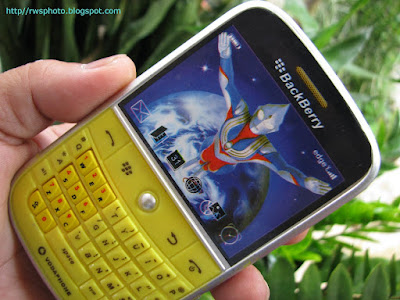 Recommended reading:
* The cheapest Black Berry in town
Recommended reading:
* The cheapest Black Berry in town
Posted by RWS at 10:08 PM 0 comments
Labels: Local Scene
Jul 27, 2010
Wisma SALCRA, Samarahan
Wisma SALCRA, the latest landmark in the District of Samarahan. Wisma SALCRA cost about RM63.1 million.
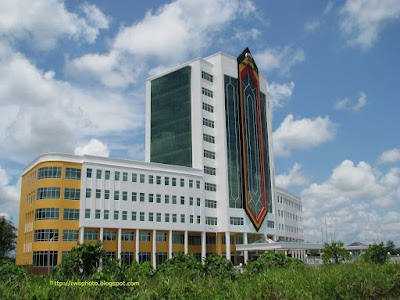 SALCRA or Sarawak Land Consolidation and Rehabilitation Authority was formed in 1976 to enable and assist the State Government in achieving the objectives of the New Economic Policy (NEP), particularly concerning the eradication of poverty. SALCRA's function, thus is to develop and manage native lands and Mixed Zone Land for Oil Palm and Tea Estates based on “in-situ” concept.
The Wisma SALCRA building does pose one question: Is it a PRIORITY to build the so-called WISMA SALCRA which cost MILLIONS where as the MONIES should be given to the land owners.
SALCRA or Sarawak Land Consolidation and Rehabilitation Authority was formed in 1976 to enable and assist the State Government in achieving the objectives of the New Economic Policy (NEP), particularly concerning the eradication of poverty. SALCRA's function, thus is to develop and manage native lands and Mixed Zone Land for Oil Palm and Tea Estates based on “in-situ” concept.
The Wisma SALCRA building does pose one question: Is it a PRIORITY to build the so-called WISMA SALCRA which cost MILLIONS where as the MONIES should be given to the land owners.
Posted by RWS at 9:36 PM 0 comments
Labels: Landmark
Jul 21, 2010
The World's Shortest Doorman
Rahmat Santoso, in his latest twenties is probably the World's Shortest Doorman. He worked at Gran Senyiur Hotel in Balikpapan, Indonesia.
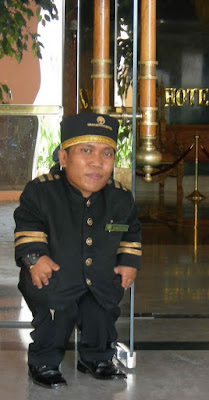 Photo: ahmadbayasut.files.wordpress.com
Photo: ahmadbayasut.files.wordpress.com
Posted by RWS at 11:33 PM 0 comments
Labels: International Pix
Jul 13, 2010
Pullman Hotel Kuching
The first Pullman hotel in Kuching. Pullman Hotel Kuching features 389 spacious and contemporary rooms with panoramic city and river views.
 The locals are saying that Pullman Hotel is "haunted". Observe the photo above, bottom left and you will likely spot a figure near one of the windows.
Photo shot from Pelita Car Park complex.
The locals are saying that Pullman Hotel is "haunted". Observe the photo above, bottom left and you will likely spot a figure near one of the windows.
Photo shot from Pelita Car Park complex.
Posted by RWS at 7:44 AM 1 comments
Jul 12, 2010
The cheapest Black Berry in town
This could be the cheapest Black Berry mobile phone in town. I mean Bleck Berry. And it only cost RM4.50 (with battery) before discount.
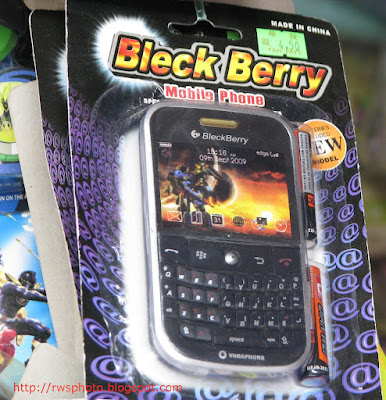 Photo shot at Asajaya bazaar in the district of Samarahan.
Photo shot at Asajaya bazaar in the district of Samarahan.
Posted by RWS at 2:41 PM 1 comments
Labels: Local Scene
Jul 9, 2010
Majlis Berambih Keluarga Persatuan Melanau Kuching
Photos shot at the Majlis Berambih Keluarga Persatuan Melanau Kuching, held on July 10, 2010 at Wisma Melanau Kuching.
 The Majlis program book.
The Majlis program book.
 The event stage.
The event stage.
 The Melanau dancers doing last minutes practice to welcome the VIP guests.
The Melanau dancers doing last minutes practice to welcome the VIP guests.
 VIP Guests - Left: Len Talif (PMK president). Center: Taib Mahmud (Chief Minister of Sarawak) and Right: Leo Toyad.
VIP Guests - Left: Len Talif (PMK president). Center: Taib Mahmud (Chief Minister of Sarawak) and Right: Leo Toyad.
 VIP Guests - Aidan Wing
VIP Guests - Aidan Wing
 VIP Guests - Left: Fatimah Abdullah. Right: Len Talif
VIP Guests - Left: Fatimah Abdullah. Right: Len Talif
 Launching of the Persatuan Melanau Kuching's official website.
What is Berambih
Berambih is a Melanau word for a casual social gathering that may involve having a meal together. The event may involve a small celebration that includes a feast, cultural show and other social activities.
Acara berambih adalah acara perjumpaan antara rakan rakan, penduduk mahupun perjumpaan antara pemimpin dan rakyat jelata.
SEO: Berambih Melanau | makna berambih | maksud berambih | apa itu berambih
Launching of the Persatuan Melanau Kuching's official website.
What is Berambih
Berambih is a Melanau word for a casual social gathering that may involve having a meal together. The event may involve a small celebration that includes a feast, cultural show and other social activities.
Acara berambih adalah acara perjumpaan antara rakan rakan, penduduk mahupun perjumpaan antara pemimpin dan rakyat jelata.
SEO: Berambih Melanau | makna berambih | maksud berambih | apa itu berambih
Posted by RWS at 7:00 PM 0 comments
Labels: Event
May 27, 2010
Tropical Wild Mushroom, Fungi, Series 11
A tiny mushroom found on the jungle floor at Mt Singai, Bau.
 Recommended reading:
* Tiny Umbrella Mushrooms, Fungi, Series 10
* Orange cup mushroom, Fungi, Series 9
* Tropical orange mushroom, Fungi, Series 8
Recommended reading:
* Tiny Umbrella Mushrooms, Fungi, Series 10
* Orange cup mushroom, Fungi, Series 9
* Tropical orange mushroom, Fungi, Series 8
Posted by RWS at 7:43 AM 2 comments
Labels: Mushroom
May 24, 2010
Bunga Misai Kuching - Orthosiphon stamineus
Orthosiphon stamineus or Misai Kucing (Malay for "Cat's Whiskers") is a traditional herb that is widely grown in tropical areas. The two general species, Orthosiphon stamineus "purple" and Orthosiphon stamineus "white" are traditionally used to treat diabetes, kidney and urinary disorders, high blood pressure and bone or muscular pain.
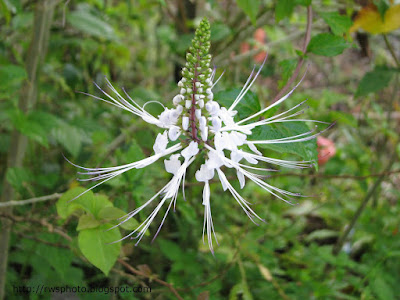 Also known as Java tea, it was possibly introduced to the west in early 20th century. Misai Kucing is popularly consumed as a herbal tea. The brewing of Java tea is similar to that for other teas. It is soaked in hot boiling water for about three minutes, before being added with honey or milk. It can be easily prepared as garden tea from the dried leaves. There are quite a number of commercial products derived from Misai Kucing.
Also known as Java tea, it was possibly introduced to the west in early 20th century. Misai Kucing is popularly consumed as a herbal tea. The brewing of Java tea is similar to that for other teas. It is soaked in hot boiling water for about three minutes, before being added with honey or milk. It can be easily prepared as garden tea from the dried leaves. There are quite a number of commercial products derived from Misai Kucing.

Posted by RWS at 12:31 PM 2 comments
Labels: Flower
About RWSPhoto Blog
Best Photo Collections
Photo Themes
- 18SX (1)
- Albino (2)
- Animal Oddities (51)
- Ant (2)
- Beach (2)
- Bintulu (1)
- Bintulu Port (2)
- Bird (5)
- branched coconut (1)
- Bugs - Hemiptera (1)
- Bugs - Hemiptera - Heteroptera (1)
- Butterfly - Junonia Orithya (1)
- Butterfly - Papilio Polymnestor (1)
- Chameleon (1)
- Container Terminal (1)
- crab (1)
- Culture (12)
- Dragon Statue (1)
- Environment (1)
- Event (6)
- Fish (7)
- Flower (8)
- freak (3)
- Fruit (8)
- fun (1)
- Fungi (11)
- Grasshopper (1)
- Insect - (70)
- Insect - Acrididae - Locust (4)
- Insect - Beetle (5)
- Insect - Bugs (11)
- Insect - Butterfly (10)
- Insect - Caterpillar (26)
- Insect - Damselfly (2)
- Insect - Dragonfly (3)
- Insect - Fly (6)
- Insect - Gerridae (1)
- Insect - Mantis (1)
- Insect - Moth (7)
- Insect - Sex (13)
- Insect - Spider (7)
- Insect - Wasps (3)
- Insect - Weevil (4)
- International Pix (53)
- Invertebrate - Millipede (2)
- Kota Kinabalu (1)
- Kuching (9)
- Landmark (6)
- Local Scene (2)
- Macaque (2)
- Menara Kidurong (1)
- Miri (1)
- Miscellaneous (4)
- Monkey Cup (1)
- Monument (1)
- Mushroom (12)
- National Park (4)
- Nature (37)
- Nepenthes (1)
- Padi (12)
- Pagoda (2)
- Pets (9)
- Photo Collection (1)
- Photo Illustration (1)
- Photo Repository (1)
- Pitcher Plant (1)
- plant (10)
- Port (1)
- Reptile (4)
- Sandakan (1)
- Sepangar Bay Container Terminal (1)
- Sepangar Port (1)
- Shoreline (3)
- Sibu (3)
- Snake (1)
- Sunset (1)
- Technology (1)
- Tropical Flower - Ixora (5)
- Tuaran (1)
- Wild Animal (7)

